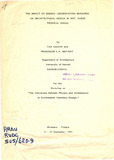The Impact Of Energy Conservation Measures On Architectural Design In Hot, Humid Tropical Areas.

View/
Date
1987Author
Asante, Yaw
Meffert, E F
Type
PresentationLanguage
enMetadata
Show full item recordAbstract
The hot, humid tropical areas are characterized by a high incidence
of thermal discomfort due to warmth for most of the year. During the
hot period bioclimatic comfort may be achieved with air conditioning or
fans, resulting in a considerable consumption of energy. This proportion
of domestic energy consumption is significant in overall energy use.
The increasing difficulty faced by almost all developing countries in
meeting the rising costs of energy supplies makes it necessary that
serious efforts be made to reduce energy consumption.
By employing energy conservation measures through the application
of bioclimatic design techniques and natural cooling systems, a
considerable reduction in energy consumption can be achieved. In
conservation-oriented design, energy consumption should be considered
as a major design factor.
For the conservation measures to have the desired impact on
overall national energy demand, governments (and parastatal bodies) have
a role to play. Through extensive information programmes, pilot
projects, building legislation and regulations, education and retraining
of experts, measures may be taken to reduce consumption of non-renewable
energy in new buildings.
Publisher
University of Nairobi
Rights
Attribution-NonCommercial-NoDerivs 3.0 United StatesUsage Rights
http://creativecommons.org/licenses/by-nc-nd/3.0/us/Collections
The following license files are associated with this item:

